Global Wildfire Outlook Forecast with Neural Networks
Abstract
1. Introduction
2. Materials and Method
2.1. Observation Datasets
2.2. Performance Indices
2.3. Forecast Models and Prediction Evaluation
- Random component: Poisson distribution
- Systematic component: A linear predictor
- Link function: Here we use a log-linear function,
3. Results and Discussion
4. Conclusions
Supplementary Materials
Author Contributions
Funding
Acknowledgments
Conflicts of Interest
References
- Liu, Y.; Goodrick, S.; Heilman, W. Wildland fire emissions, carbon, and climate: Wildfire–climate interactions. For. Ecol. Manag. 2014, 317, 80–96. [Google Scholar] [CrossRef]
- Herron-Thorpe, F.L.; Mount, G.H.; Emmons, L.K.; Lamb, B.K.; Jaffe, D.A.; Wigder, N.L.; Chung, S.H.; Zhang, R.; Woelfle, M.D.; Vaughan, J.K. Air quality simulations of wildfires in the Pacific Northwest evaluated with surface and satellite observations during the summers of 2007 and 2008. Atmos. Chem. Phys. 2014, 14, 12533–12551. [Google Scholar] [CrossRef]
- Miller, D.J.; Sun, K.; Zondlo, M.A.; Kanter, D.; Dubovik, O.; Welton, E.J.; Winker, D.M.; Ginoux, P. Assessing boreal forest fire smoke aerosol impacts on U.S. air quality: A case study using multiple data sets. J. Geophys. Res. Atmos. 2011, 116. [Google Scholar] [CrossRef]
- Mallia, D.V.; Lin, J.C.; Urbanski, S.; Ehleringer, J.; Nehrkorn, T. Impacts of upwind wildfire emissions on CO, CO2, and PM2.5 concentrations in Salt Lake City, Utah. J. Geophys. Res. Atmos. 2015, 120, 147–166. [Google Scholar] [CrossRef]
- Zou, Y.F.; Wang, Y.H.; Ke, Z.M.; Tian, H.Q.; Yang, J.; Liu, Y.Q. Development of a REgion-Specific ecosystem feedback Fire (RESFire) model in the Community Earth System Model. J. Adv. Modeling Earth Syst. 2017, 11, 417–445. [Google Scholar] [CrossRef]
- Sommers, W.T.; Loehman, R.A.; Hardy, C.C. Wild land fire emissions, carbon, and climate: Science overview and knowledge needs. For. Ecol. Manag. 2014, 317, 1–8. [Google Scholar] [CrossRef]
- Loehman, R.A.; Reinhardt, E.; Riley, K.L. Wildland fire emissions, carbon, and climate: Seeing the forest and the trees—A cross-scale assessment of wildfire and carbon dynamics in fire-prone, forested ecosystems. For. Ecol. Manag. 2014, 317, 9–19. [Google Scholar] [CrossRef]
- Paschalidou, A.K.; Kassomenos, P.A. What are the most fire-dangerous atmospheric circulations in the Eastern-Mediterranean? Analysis of the synoptic wildfire climatology. Sci. Total Environ. 2016, 539, 536–545. [Google Scholar] [CrossRef]
- van der Werf, G.R.; Dempewolf, J.; Trigg, S.N.; Randerson, J.T.; Kasibhatla, P.S.; Gigliof, L.; Murdiyarso, D.; Peters, W.; Morton, D.C.; Collatz, G.J.; et al. Climate regulation of fire emissions and deforestation in equatorial Asia. Proc. Natl. Acad. Sci. USA 2008, 105, 20350–20355. [Google Scholar] [CrossRef]
- Ward, D.S.; Shevliakova, E.; Malyshev, S.; Lamarque, J.F.; Wittenberg, A.T. Variability of fire emissions on interannual to multi-decadal timescales in two Earth System models. Environ. Res. Lett. 2016, 11, 125008. [Google Scholar] [CrossRef]
- Drosdowsky, W.; Wheeler, M.C. Predicting the Onset of the North Australian Wet Season with the POAMA Dynamical Prediction System. Weather Forecast. 2014, 29, 150–161. [Google Scholar] [CrossRef]
- Rabin, S.S.; Melton, J.R.; Lasslop, G.; Bachelet, D.; Forrest, M.; Hantson, S.; Kaplan, J.O.; Li, F.; Mangeon, S.; Ward, D.S.; et al. The Fire Modeling Intercomparison Project (FireMIP), phase 1: Experimental and analytical protocols with detailed model descriptions. Geosci. Model Dev. 2017, 10, 1175–1197. [Google Scholar] [CrossRef]
- Chen, Y.; Randerson, J.T.; Morton, D.C.; DeFries, R.S.; Collatz, G.J.; Kasibhatla, P.S.; Giglio, L.; Jin, Y.F.; Marlier, M.E. Forecasting Fire Season Severity in South America Using Sea Surface Temperature Anomalies. Science 2011, 334, 787–791. [Google Scholar] [CrossRef] [PubMed]
- Chen, Y.; Morton, D.C.; Andela, N.; Giglio, L.; Randerson, J.T. How much global burned area can be forecast on seasonal time scales using sea surface temperatures? Environ. Res. Lett. 2016, 11, 045001. [Google Scholar] [CrossRef]
- Chen, Y.; Randerson, J.T.; Morton, D.C. Tropical North Atlantic ocean-atmosphere interactions synchronize forest carbon losses from hurricanes and Amazon fires. Geophys. Res. Lett. 2015, 42, 6462–6470. [Google Scholar] [CrossRef]
- Archibald, S.; Roy, D.P.; van Wilgen, B.W.; Scholes, R.J. What limits fire? An examination of drivers of burnt area in Southern Africa. Glob. Chang. Biol. 2009, 15, 613–630. [Google Scholar] [CrossRef]
- Gudmundsson, L.; Rego, F.C.; Rocha, M.; Seneviratne, S.I. Predicting above normal wildfire activity in southern Europe as a function of meteorological drought. Environ. Res. Lett. 2014, 9, 084008. [Google Scholar] [CrossRef]
- Guo, F.T.; Su, Z.W.; Wang, G.Y.; Sun, L.; Lin, F.F.; Liu, A.Q. Wildfire ignition in the forests of southeast China: Identifying drivers and spatial distribution to predict wildfire likelihood. Appl. Geogr. 2016, 66, 12–21. [Google Scholar] [CrossRef]
- Finney, M.; Grenfell, I.C.; McHugh, C.W. Modeling Containment of Large Wildfires Using Generalized Linear Mixed-Model Analysis. For. Sci. 2009, 55, 249–255. [Google Scholar]
- Lehsten, V.; Harmand, P.; Palumbo, I.; Arneth, A. Modelling burned area in Africa. Biogeosciences 2010, 7, 3199–3214. [Google Scholar] [CrossRef]
- Bar Massada, A.; Syphard, A.D.; Stewart, S.I.; Radeloff, V.C. Wildfire ignition-distribution modelling: A comparative study in the Huron-Manistee National Forest, Michigan, USA. Int. J. Wildland Fire 2013, 22, 174–183. [Google Scholar] [CrossRef]
- Vilar, L.; Gomez, I.; Martinez-Vega, J.; Echavarria, P.; Riano, D.; Martin, P. Multitemporal Modelling of Socio-Economic Wildfire Drivers in Central Spain between the 1980s and the 2000s: Comparing Generalized Linear Models to Machine Learning Algorithms. PLoS ONE 2016, 11, e0161344. [Google Scholar] [CrossRef] [PubMed]
- Song, C.; Kwan, M.P.; Zhu, J.P. Modeling Fire Occurrence at the City Scale: A Comparison between Geographically Weighted Regression and Global Linear Regression. Int. J. Environ. Res. Public Health 2017, 14, 396. [Google Scholar] [CrossRef] [PubMed]
- Heaney, K.D.; Rowe, W.F. The application of linear-regression to range-of-fire estimates based on the spread of shotgun pellet patterns. J. Forensic Sci. 1983, 28, 433–436. [Google Scholar] [CrossRef]
- Amatulli, G.; Rodrigues, M.J.; Trombetti, M.; Lovreglio, R. Assessing long-term fire risk at local scale by means of decision tree technique. J. Geophys. Res. Biogeosc. 2006, 111. [Google Scholar] [CrossRef]
- Miquelajauregui, Y.; Cumming, S.G.; Gauthier, S. Modelling Variable Fire Severity in Boreal Forests: Effects of Fire Intensity and Stand Structure. PLoS ONE 2016, 11, e0150073. [Google Scholar] [CrossRef]
- Salehi, M.; Rusu, L.I.; Lynar, T.; Phan, A. Dynamic and Robust Wildfire Risk Prediction System. In Proceedings of the 22nd ACM SIGKDD International Conference on Knowledge Discovery and Data Mining—KDD ‘16, San Francisco, CA, USA, 13–17 August 2016; pp. 245–254. [Google Scholar]
- Rodriguez-Aseretto, D.; de Rigo, D.; Di Leo, M.; Cortes, A.; San-Miguel-Ayanz, J. A data-driven model for large wildfire behaviour prediction in Europe. Procedia Comput. Sci. 2013, 18, 1861–1870. [Google Scholar] [CrossRef]
- Reid, C.E.; Jerrett, M.; Tager, I.B.; Petersen, M.L.; Mann, J.K.; Balmes, J.R. Differential respiratory health effects from the 2008 northern California wildfires: A spatiotemporal approach. Enviorn. Res. 2016, 150, 227–235. [Google Scholar] [CrossRef]
- Reid, C.E.; Jerrett, M.; Petersen, M.L.; Pfister, G.G.; Morefield, P.E.; Tager, I.B.; Raffuse, S.M.; Balmes, J.R. Spatiotemporal Prediction of Fine Particulate Matter During the 2008 Northern California Wildfires Using Machine Learning. Environ. Sci. Technol. 2015, 49, 3887–3896. [Google Scholar] [CrossRef]
- San-Miguel-Ayanz, J.; Schulte, E.; Schmuck, G.; Camia, A. The European Forest Fire Information System in the context of environmental policies of the European Union. For. Policy Econ. 2013, 29, 19–25. [Google Scholar] [CrossRef]
- de Souza, F.T.; Koerner, T.; Chlad, R. A data-based model for predicting wildfires in Chapada das Mesas National Park in the State of Maranho. Environ. Earth Sci. 2015, 74, 3603–3611. [Google Scholar] [CrossRef]
- Guo, C.; Berkhahn, F. Entity Embeddings of Categorical Variables. arXiv 2016, arXiv:Abs/1604.06737. [Google Scholar]
- Safi, Y.; Bouroumi, A. Prediction of forest fires using Artificial neural networks. Appl. Math. Sci. 2013, 7, 271–286. [Google Scholar] [CrossRef]
- Sevinc, V.; Kucuk, O.; Goltas, M. A Bayesian network model for prediction and analysis of possible forest fire causes. For. Ecol. Manag. 2020, 457, 117723. [Google Scholar] [CrossRef]
- Yu, Y.; Omar, R.; Harrison, R.; Sammathuria, M.; Nik, A.R. Pattern clustering of forest fires based on meteorological variables and its classification using hybrid data mining methods. J. Comput. Biol. Bioinfomatics Res. 2011, 3, 47–52. [Google Scholar]
- Castelli, M.; Vanneschi, L.; Popovič, A. Predicting Burned Areas of Forest Fires: An Artificial Intelligence Approach. Fire Ecol. 2015, 11, 106–118. [Google Scholar] [CrossRef]
- Alberg, D. An Interval Tree Approach to Predict Forest Fires using Meteorological Data. Int. J. Comput. Appl. 2015, 132, 17–22. [Google Scholar] [CrossRef]
- Mayr, M.J.; Vanselow, K.A.; Samimi, C. Fire regimes at the arid fringe: A 16-year remote sensing perspective (2000–2016) on the controls of fire activity in Namibia from spatial predictive models. Ecol. Indic. 2018, 91, 324–337. [Google Scholar] [CrossRef]
- Kozik, V.; Nezhevenko, E.; Feoktistov, A. Studying the method of adaptive prediction of forest fire evolution on the basis of recurrent neural networks. Optoelectron. Instrum. Data Process. 2014, 50, 395–401. [Google Scholar] [CrossRef]
- Lin, G.; Milan, A.; Shen, C.; Reid, I.D. RefineNet: Multi-path Refinement Networks for High-Resolution Semantic Segmentation. In Proceedings of the IEEE Conference on Computer Vision and Pattern Recognition; 2017; pp. 5168–5177. Available online: https://arxiv.org/abs/1611.06612 (accessed on 13 July 2020).
- Cortez, P.; Morais, A. A Data Mining Approach to Predict Forest Fires using Meteorological Data; 2007; Available online: http://www3.dsi.uminho.pt/pcortez/fires.pdf (accessed on 13 July 2020).
- Liang, H.; Zhang, M.; Wang, H. A Neural Network Model for Wildfire Scale Prediction Using Meteorological Factors. IEEE Access 2019, 7, 176746–176755. [Google Scholar] [CrossRef]
- Xie, Y.; Peng, M. Forest fire forecasting using ensemble learning approaches. Neural Comput. Appl. 2019, 31, 4541–4550. [Google Scholar] [CrossRef]
- Makridakis, S.; Spiliotis, E.; Assimakopoulos, V. The M4 Competition: Results, findings, conclusion and way forward. Int. J. Forecast. 2018, 34, 802–808. [Google Scholar] [CrossRef]
- Saha, S.; Moorthi, S.; Wu, X.; Wang, J.; Nadiga, S.; Tripp, P.; Behringer, D.; Hou, Y.-T.; Chuang, H.-y.; Iredell, M.; et al. The NCEP Climate Forecast System Version 2. J. Clim. 2014, 27, 2185–2208. [Google Scholar] [CrossRef]
- Randerson, J.T.; Chen, Y.; van der Werf, G.R.; Rogers, B.M.; Morton, D.C. Global burned area and biomass burning emissions from small fires. J. Geophys. Res. Biogeosci. 2012, 117, 23. [Google Scholar] [CrossRef]
- Saha, S.; Moorthi, S.; Pan, H.L.; Wu, X.R.; Wang, J.D.; Nadiga, S.; Tripp, P.; Kistler, R.; Woollen, J.; Behringer, D.; et al. The NCEP climate forecast system reanalysis. Bull. Amer. Meteorol. Soc. 2010, 91, 1015–1057. [Google Scholar] [CrossRef]
- Chen, W.Y.; Van den Dool, H. Sensitivity of Teleconnection Patterns to the Sign of Their Primary Action Center. Mon. Weather Rev. 2003, 131, 2885–2899. [Google Scholar] [CrossRef]
- Liu, J.; Tang, W.; Chen, G.; Lu, Y.; Feng, C.; Tu, X.M. Correlation and agreement: Overview and clarification of competing concepts and measures. Shanghai Arch Psychiatry 2016, 28, 115–120. [Google Scholar] [CrossRef]
- Yang, J.M.; Yang, J.Y.; Liu, S.; Hoogenboom, G. An evaluation of the statistical methods for testing the performance of crop models with observed data. Agric. Syst. 2014, 127, 81–89. [Google Scholar] [CrossRef]
- Shen, M.; Chen, J.; Zhuan, M.; Chen, H.; Xu, C.-Y.; Xiong, L. Estimating uncertainty and its temporal variation related to global climate models in quantifying climate change impacts on hydrology. J. Hydrol. 2018, 556, 10–24. [Google Scholar] [CrossRef]
- Nash, J.E.; Sutcliffe, J.V. River flow forecasting through conceptual models part I—A discussion of principles. J. Hydrol. 1970, 10, 9. [Google Scholar] [CrossRef]
- Mielke, P.W.; Berry, K.J. Permutation Methods A Distance Function Approach Introduction. In Permutation Methods: A Distance Function Approach, 2nd ed.; Springer Science & Business Media: Berlin, Germany, 2007; pp. 1–10. [Google Scholar]
- Legates, D.R.; McCabe, G.J. Evaluating the use of “goodness-of-fit” measures in hydrologic and hydroclimatic model validation. Water Resour. Res. 1999, 35, 233–241. [Google Scholar] [CrossRef]
- Boylan, J.W.; Russell, A.G. PM and light extinction model performance metrics, goals, and criteria for three-dimensional air quality models. Atmos. Environ. 2006, 40, 4946–4959. [Google Scholar] [CrossRef]
- Ghim, Y.S.; Choi, Y.; Kim, S.; Bae, C.H.; Park, J.; Shin, H.J. Evaluation of Model Performance for Forecasting Fine Particle Concentrations in Korea. Aerosol Air Qual. Res. 2017, 17, 1856–1864. [Google Scholar] [CrossRef]
- Boadi, C.; Harvey, S.K.; Gyeke-dako, A. Modelling of fire count data: Fire disaster risk in Ghana. SpringerPlus 2015, 4, 794. [Google Scholar] [CrossRef] [PubMed][Green Version]
- Papadopoulos, A.; Paschalidou, A.K.; Kassomenos, P.A.; McGregor, G. On the association between synoptic circulation and wildfires in the Eastern Mediterranean. Theor. Appl. Climatol. 2014, 115, 483–501. [Google Scholar] [CrossRef]
- Jiang, Y.Y.; Zhuang, Q.L.; Mandallaz, D. Modeling Large Fire Frequency and Burned Area in Canadian Terrestrial Ecosystems with Poisson Models. Environ. Model. Assess. 2012, 17, 483–493. [Google Scholar] [CrossRef]
- Giglio, L.; Randerson, J.T.; van der Werf, G.R. Analysis of daily, monthly, and annual burned area using the fourth-generation global fire emissions database (GFED4). J. Geophys. Res. Biogeosci. 2013, 118, 317–328. [Google Scholar] [CrossRef]
- Flannigan, M.D.; Krawchuk, M.A.; de Groot, W.J.; Wotton, B.M.; Gowman, L.M. Implications of changing climate for global wildland fire. Int. J. Wildland Fire 2009, 18, 483–507. [Google Scholar] [CrossRef]
- Frolking, S.; Talbot, J.; Jones, M.C.; Treat, C.C.; Kauffman, J.B.; Tuittila, E.S.; Roulet, N. Peatlands in the Earth’s 21st century climate system. Environ. Rev. 2011, 19, 371–396. [Google Scholar] [CrossRef]
- Westerling, A.L.; Bryant, B.P. Climate change and wildfire in California. Clim. Chang. 2008, 87, S231–S249. [Google Scholar] [CrossRef]
- Papadopoulos, A.; Paschalidou, A.K.; Kassomenos, P.A.; McGregor, G. Investigating the relationship of meteorological/climatological conditions and wildfires in Greece. Theor. Appl. Climatol. 2013, 112, 113–126. [Google Scholar] [CrossRef]
- Kim, P.S.; Jacob, D.J.; Mickley, L.J.; Koplitz, S.N.; Marlier, M.E.; DeFries, R.S.; Myers, S.S.; Chew, B.N.; Mao, Y.H.H. Sensitivity of population smoke exposure to fire locations in Equatorial Asia. Atmos. Environ. 2015, 102, 11–17. [Google Scholar] [CrossRef]
- Crippa, P.; Castruccio, S.; Archer-Nicholls, S.; Lebron, G.B.; Kuwata, M.; Thota, A.; Sumin, S.; Butt, E.; Wiedinmyer, C.; Spracklen, D.V. Population exposure to hazardous air quality due to the 2015 fires in Equatorial Asia. Sci. Rep. 2016, 6, 1–9. [Google Scholar] [CrossRef] [PubMed]
- Ruddell, B.L.; Kumar, P. Ecohydrologic process networks: 2. Analysis and characterization. Water Resour. Res. 2009, 45. [Google Scholar] [CrossRef]
- Ruddell, B.L.; Kumar, P. Ecohydrologic process networks: 1. Identification. Water Resour. Res. 2009, 45. [Google Scholar] [CrossRef]
- Imada, A. A Literature Review: Forest Management with Neural Network and Artificial Intelligence. In Neural Networks and Artificial Intelligence; Springer: Cham, Switzerland, 2014; Volume 440, pp. 9–21. [Google Scholar]
- Dimuccio, L.A.; Ferreira, R.; Cunha, L.; de Almeida, A.C. Regional forest-fire susceptibility analysis in central Portugal using a probabilistic ratings procedure and artificial neural network weights assignment. Int. J. Wildland Fire 2011, 20, 776–791. [Google Scholar] [CrossRef]
- Hagan, M.T.; Demuth, H.B.; Beale, M.; De Jesús, O. Neural Network Design; Martin, H., Ed.; 2014; Available online: https://hagan.okstate.edu/NNDesign.pdf (accessed on 13 July 2020).
- Hagan, M.T.; Menhaj, M.B. Training feedforward networks with the marquardt algorithm. IEEE Trans. Neural Netw. 1994, 5, 989–993. [Google Scholar] [CrossRef] [PubMed]
- Vasilakos, C.; Kalabokidis, K.; Hatzopoulos, J.; Matsinos, I. Identifying wildland fire ignition factors through sensitivity analysis of a neural network. Nat. Hazards 2009, 50, 125–143. [Google Scholar] [CrossRef]
- Li, L.M.; Song, W.G.; Ma, J.; Satoh, K. Artificial neural network approach for modeling the impact of population density and weather parameters on forest fire risk. Int. J. Wildland Fire 2009, 18, 640–647. [Google Scholar] [CrossRef]
- Tosca, M.G.; Diner, D.J.; Garay, M.J.; Kalashnikova, O.V. Human-caused fires limit convection in tropical Africa: First temporal observations and attribution. Geophys. Res. Lett. 2015, 42, 6492–6501. [Google Scholar] [CrossRef]
- Attorre, F.; Govender, N.; Hausmann, A.; Farcomeni, A.; Guillet, A.; Scepi, E.; Smit, I.P.J.; Vitale, M. Assessing the effect of management changes and environmental features on the spatio-temporal pattern of fire in an African Savanna Fire spatio-temporal pattern. J. Nat. Conserv. 2015, 28, 1–10. [Google Scholar] [CrossRef]
- Strydom, S.; Savage, M.J. A spatio-temporal analysis of fires in South Africa. S. Afr. J. Sci. 2016, 112, 8. [Google Scholar] [CrossRef]
- Zhang, H.L.; Chen, G.; Hu, J.L.; Chen, S.H.; Wiedinmyer, C.; Kleeman, M.; Ying, Q. Evaluation of a seven-year air quality simulation using the Weather Research and Forecasting (WRF)/Community Multiscale Air Quality (CMAQ) models in the eastern United States. Sci. Total Environ. 2014, 473, 275–285. [Google Scholar] [CrossRef] [PubMed]
- Chen, Y.; Morton, D.C.; Jin, Y.F.; Collatz, G.J.; Kasibhatla, P.S.; van der Werf, G.R.; DeFries, R.S.; Randerson, J.T. Long-term trends and interannual variability of forest, savanna and agricultural fires in South America. Carbon Manag. 2014, 5, 108. [Google Scholar] [CrossRef]
- Lehsten, V.; Tansey, K.; Balzter, H.; Thonicke, K.; Spessa, A.; Weber, U.; Smith, B.; Arneth, A. Estimating carbon emissions from African wildfires. Biogeosciences 2009, 6, 349–360. [Google Scholar] [CrossRef]
- Cai, W.; Cowan, T.; Raupach, M. Positive Indian Ocean Dipole events precondition southeast Australia bushfires. Geophys. Res. Lett. 2009, 36, 6. [Google Scholar] [CrossRef]
- Williams, A.A.J.; Karoly, D.J.; Tapper, N. The sensitivity of Australian fire danger to climate change. Clim. Chang. 2001, 49, 171–191. [Google Scholar] [CrossRef]
- King, K.J.; de Ligt, R.M.; Cary, G.J. Changes in fire and carbon dynamics for projected future climates in the south eastern Australian high country. In Proceedings of the 18th World Imacs Congress and Modsim09 International Congress on Modelling and Simulation: Interfacing Modelling and Simulation with Mathematical and Computational Sciences, Cairns, Australia, 13–17 July 2009; pp. 2569–2575. [Google Scholar]
- Doblas-Reyes, F.J.; Weisheimer, A.; Deque, M.; Keenlyside, N.; McVean, M.; Murphy, J.M.; Rogel, P.; Smith, D.; Palmer, T.N. Addressing model uncertainty in seasonal and annual dynamical ensemble forecasts. Q. J. R. Meteorol. Soc. 2009, 135, 1538–1559. [Google Scholar] [CrossRef]
- Mo, K.C.; Shukla, S.; Lettenmaier, D.P.; Chen, L.C. Do Climate Forecast System (CFSv2) forecasts improve seasonal soil moisture prediction? Geophys. Res. Lett. 2012, 39, 6. [Google Scholar] [CrossRef]
- Strobach, E.; Bel, G. Improvement of climate predictions and reduction of their uncertainties using learning algorithms. Atmos. Chem. Phys. 2015, 15, 8631–8641. [Google Scholar] [CrossRef]
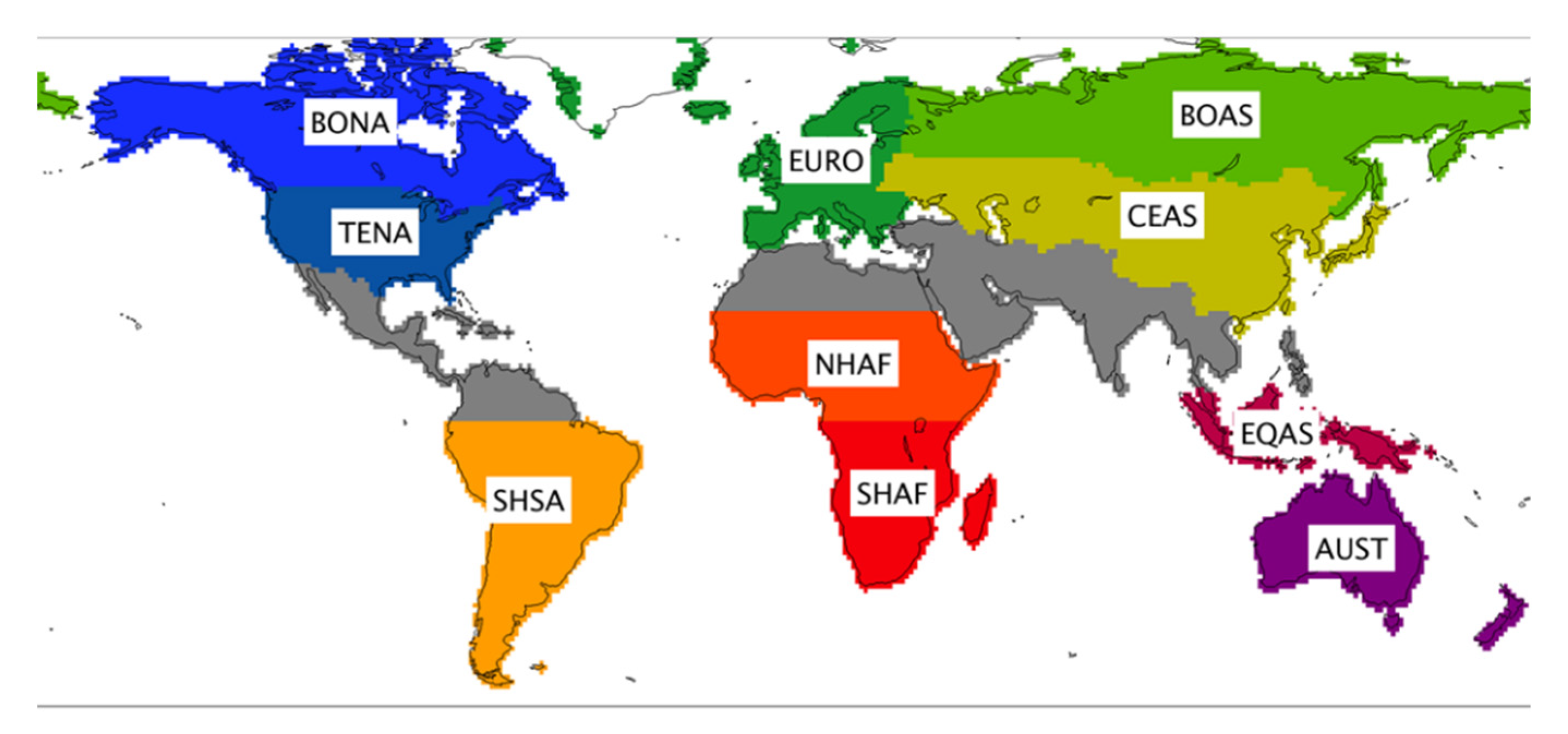
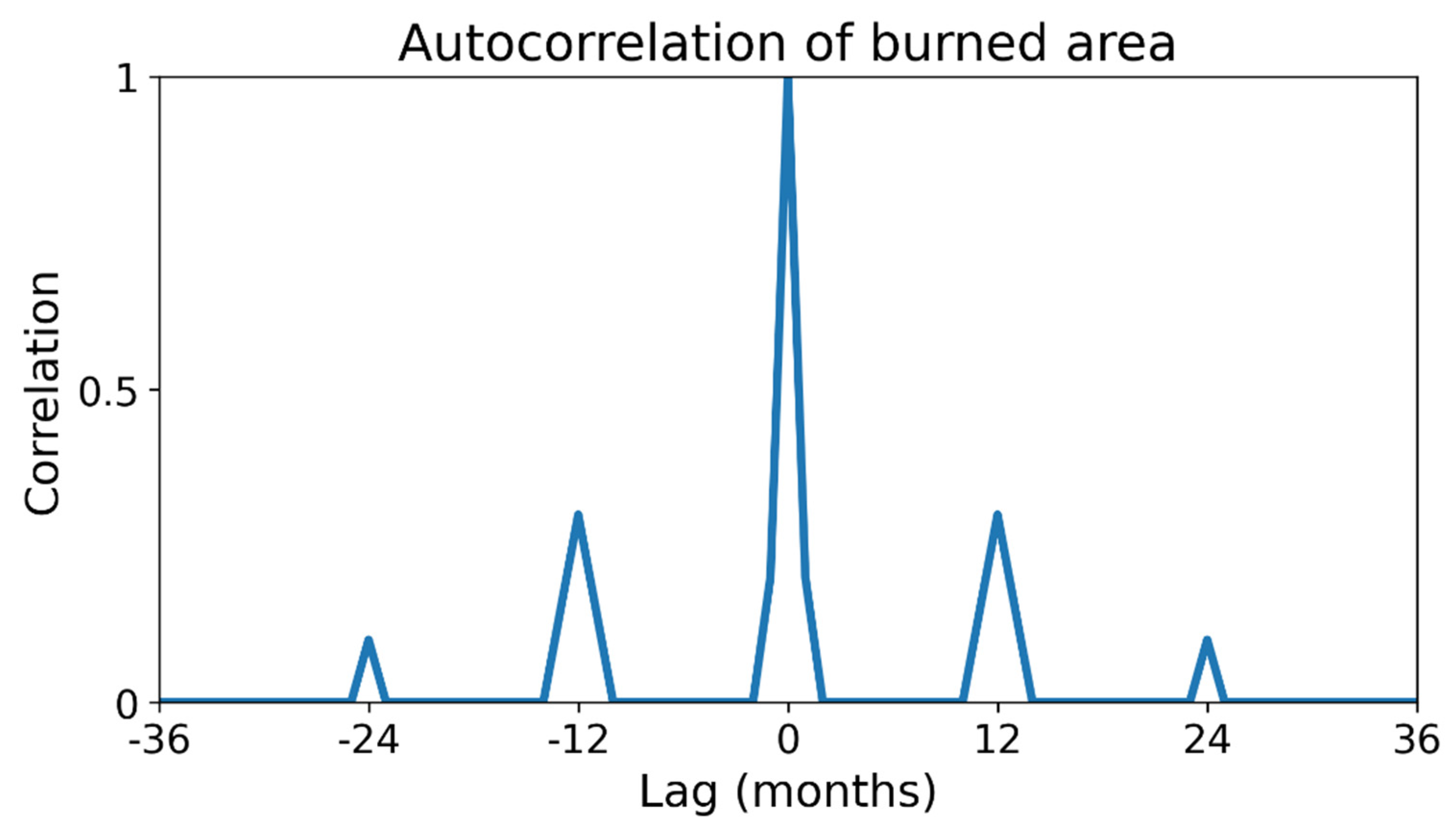
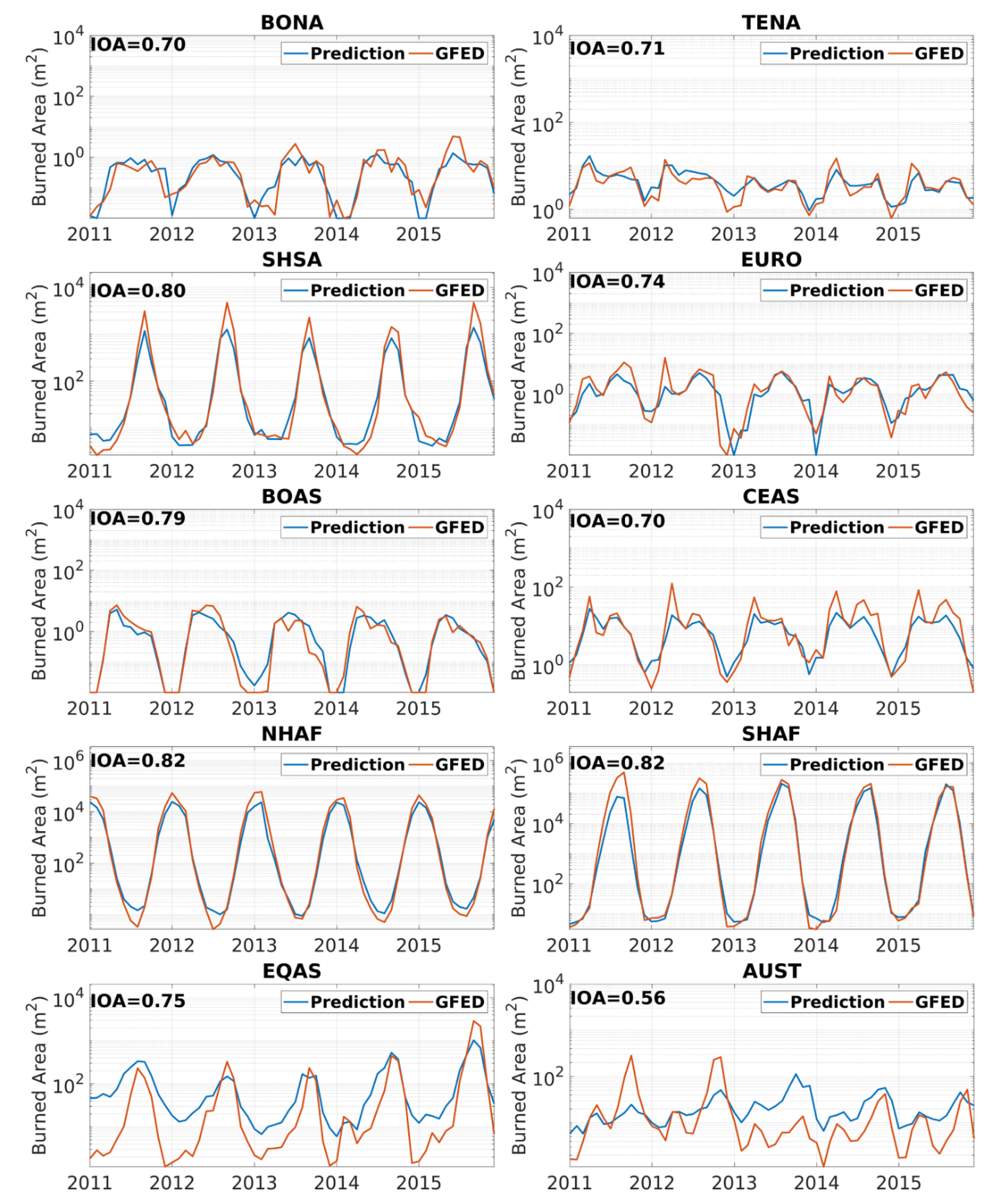
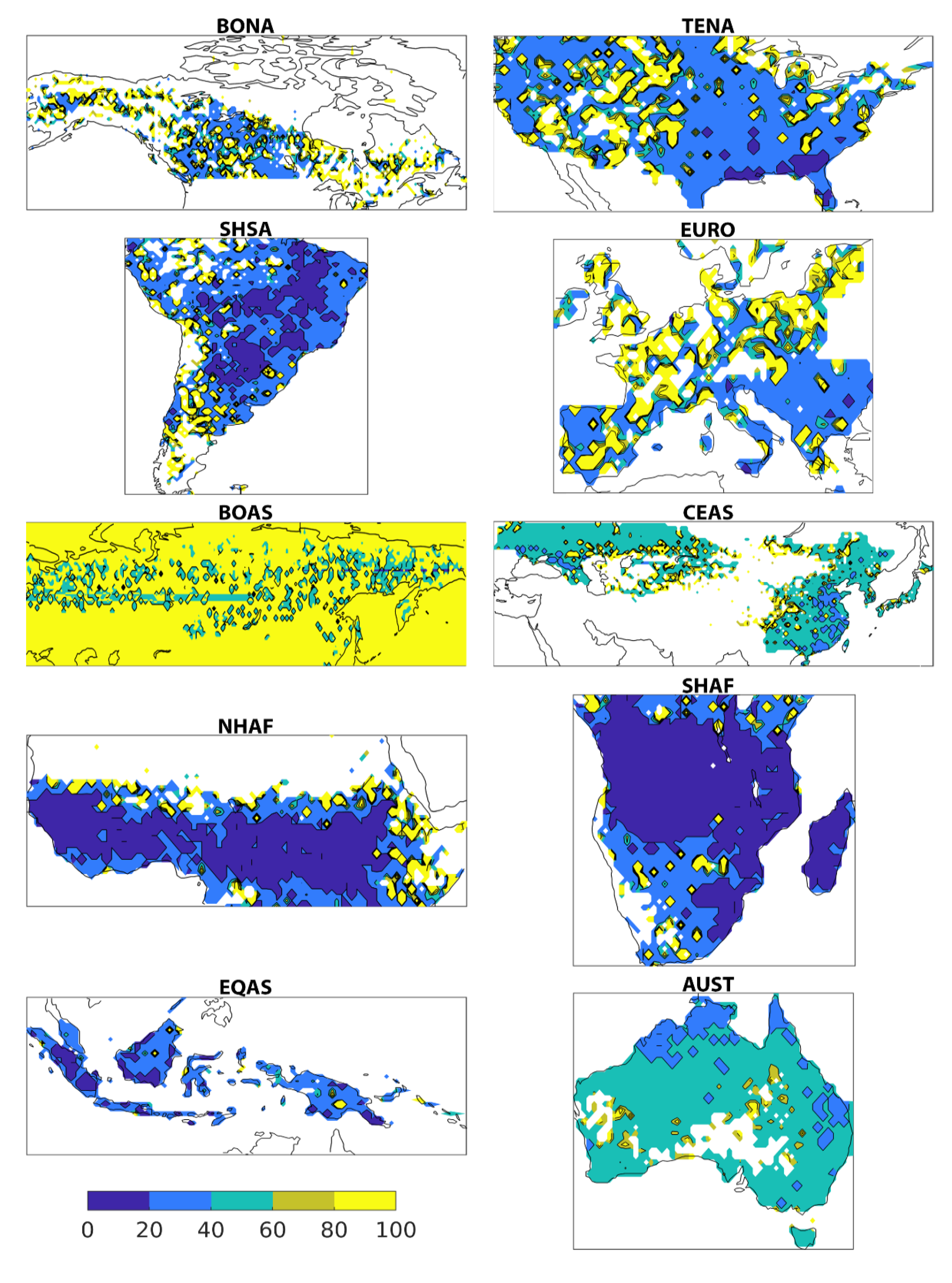
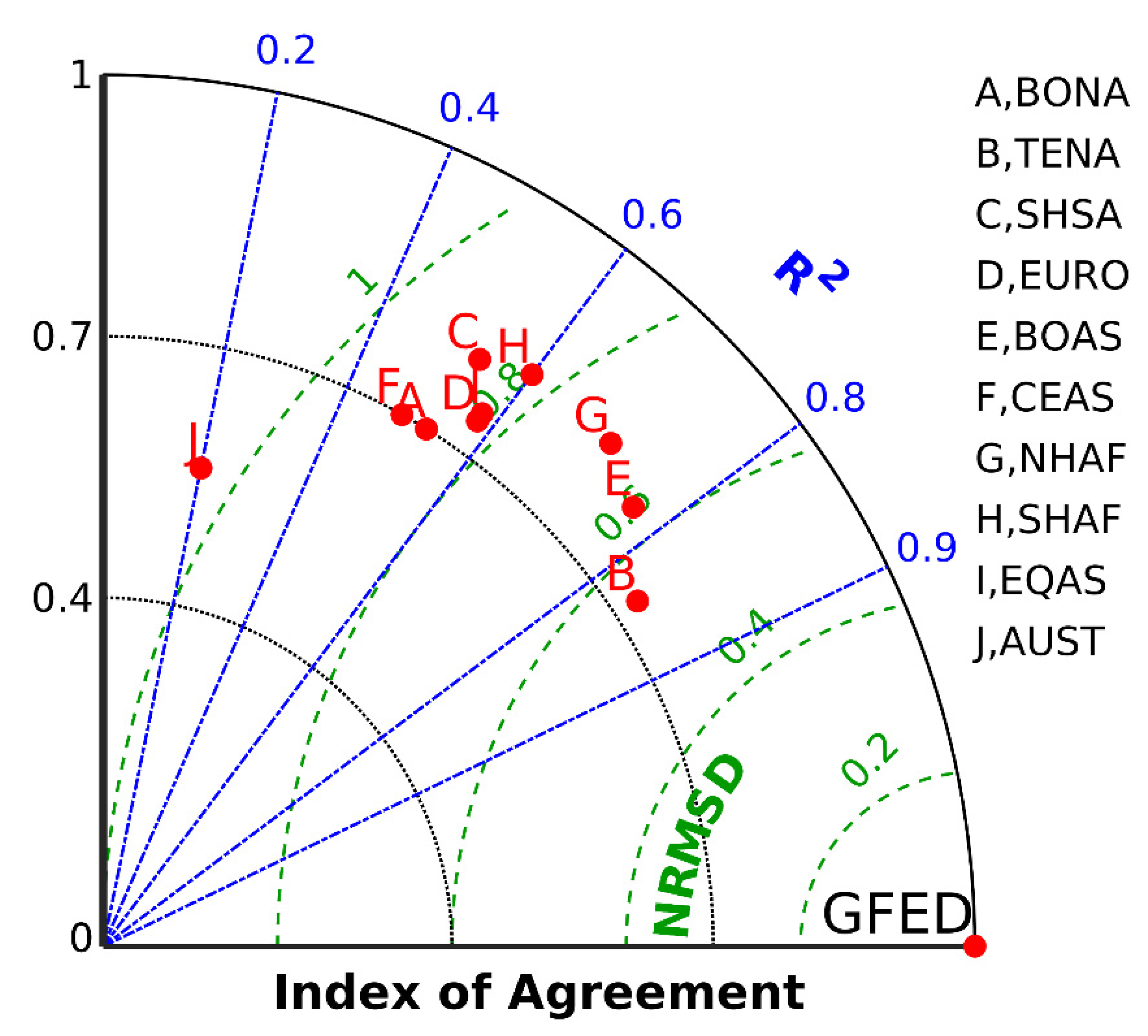
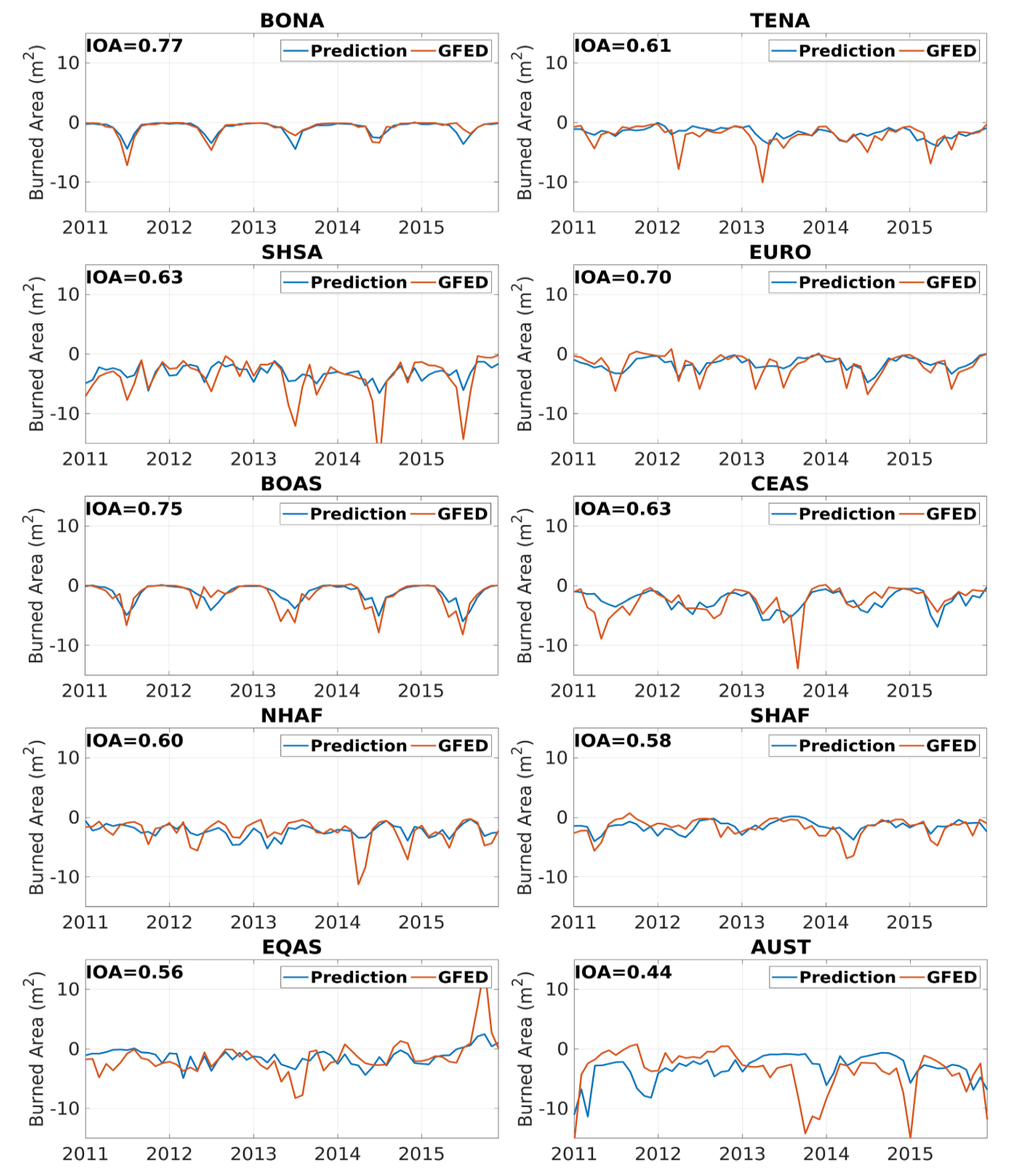
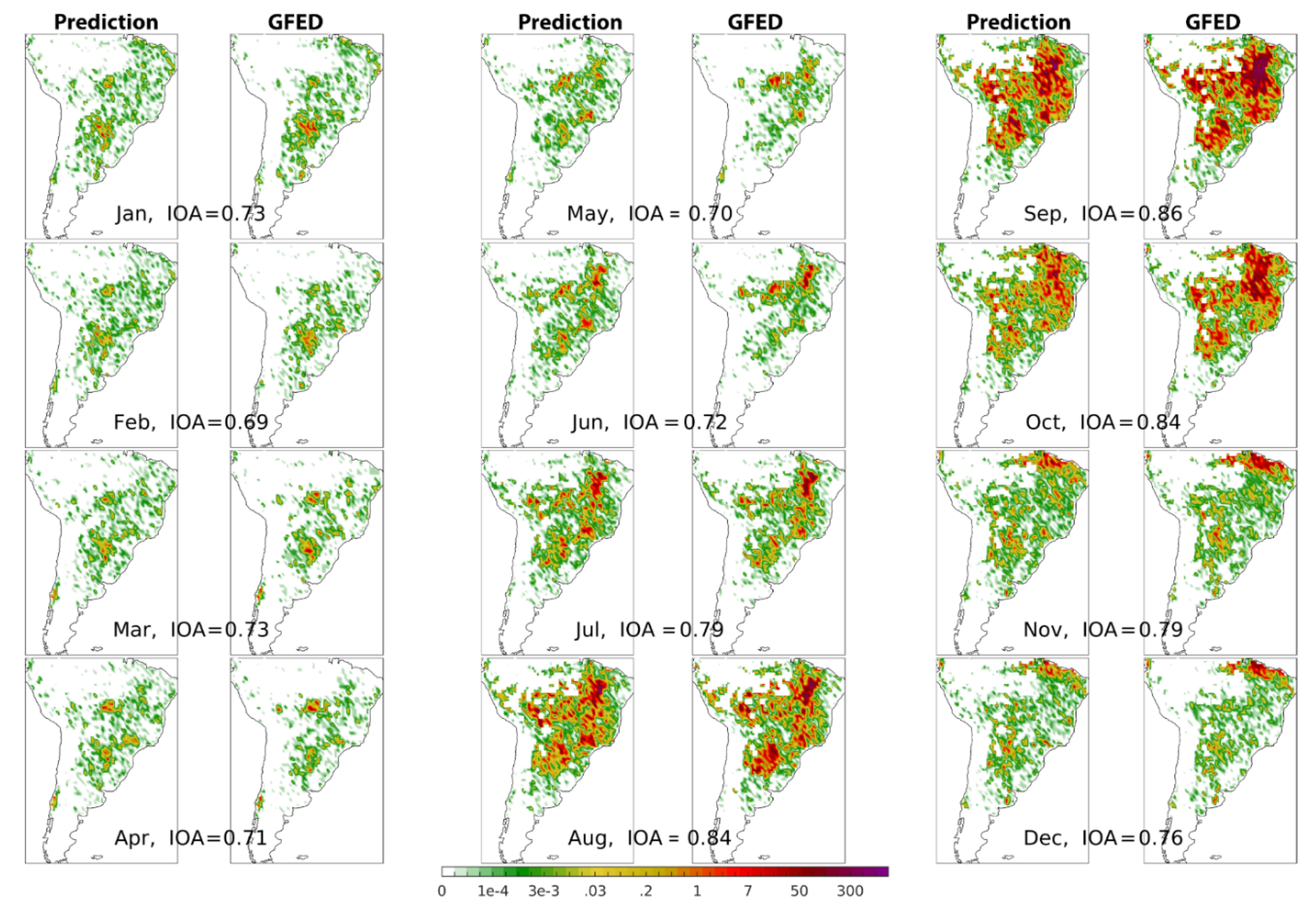
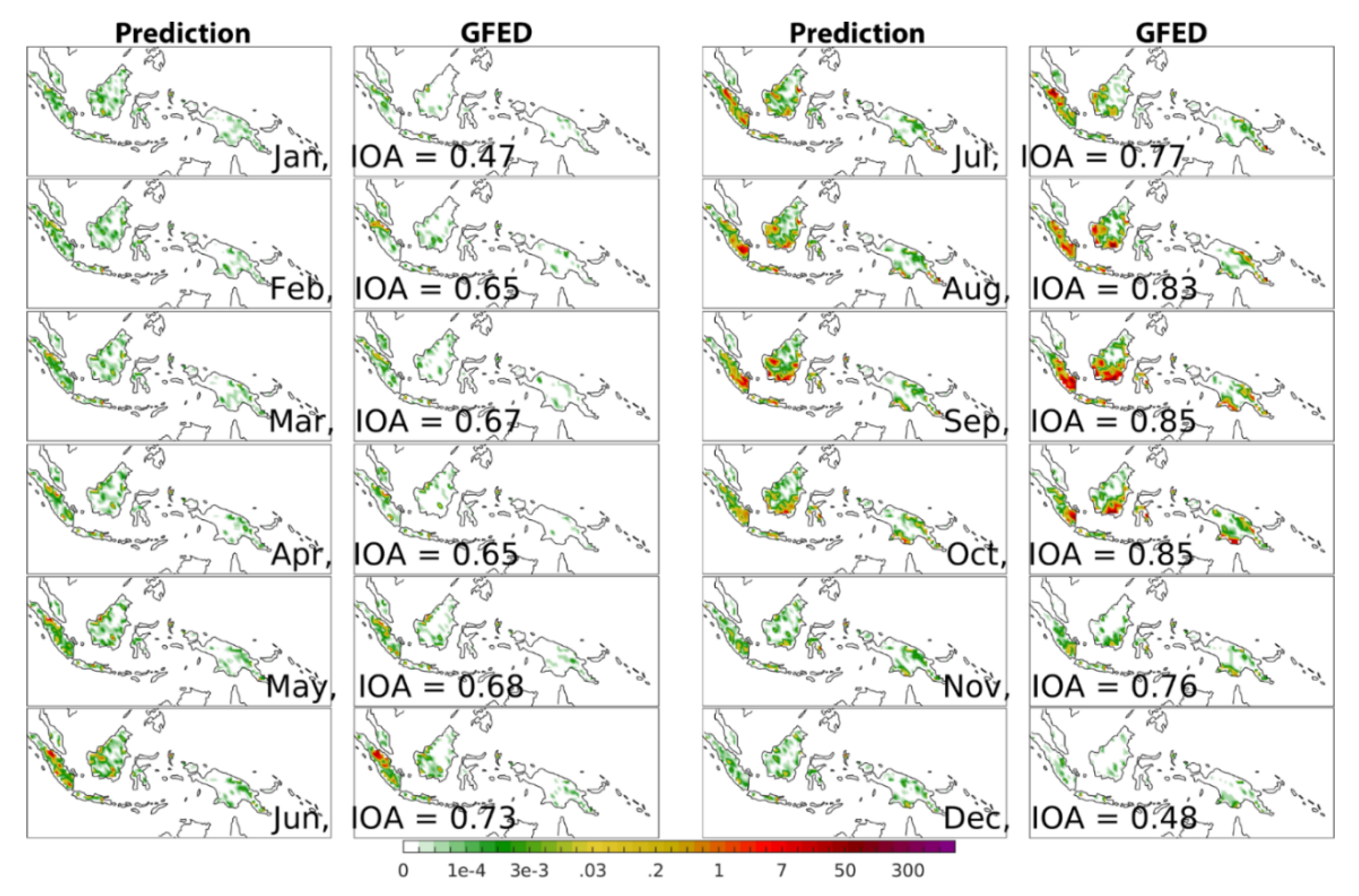
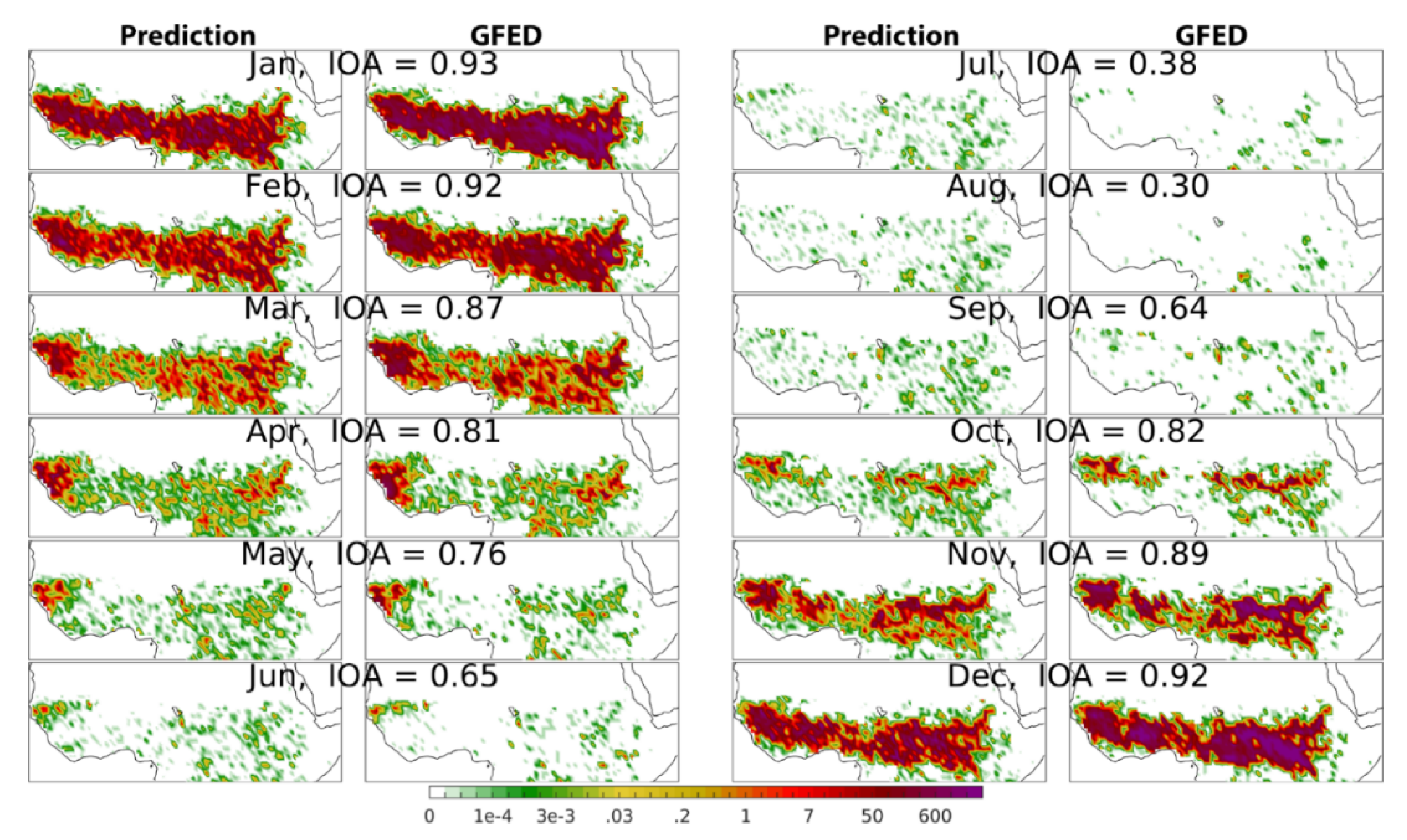
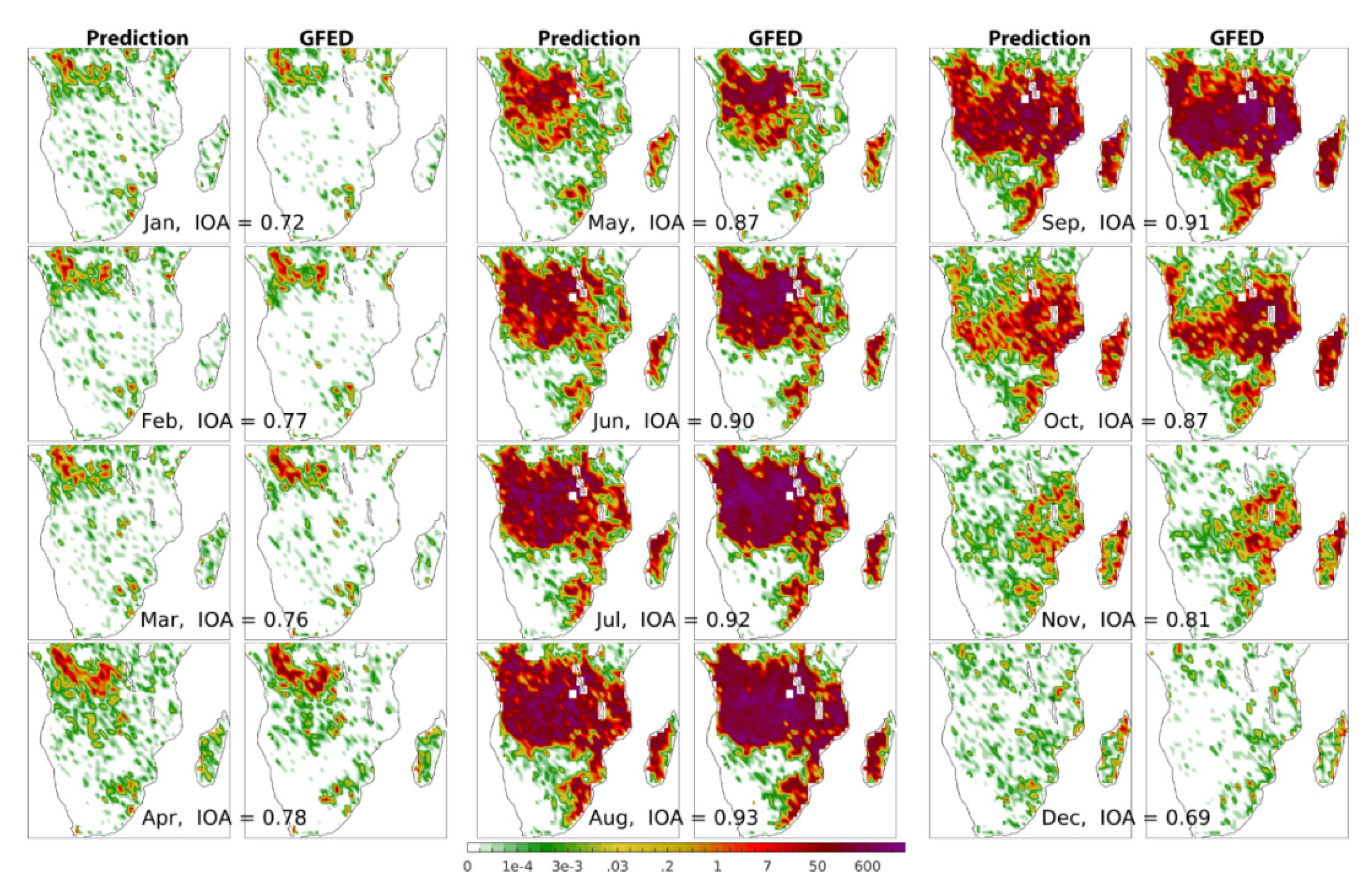
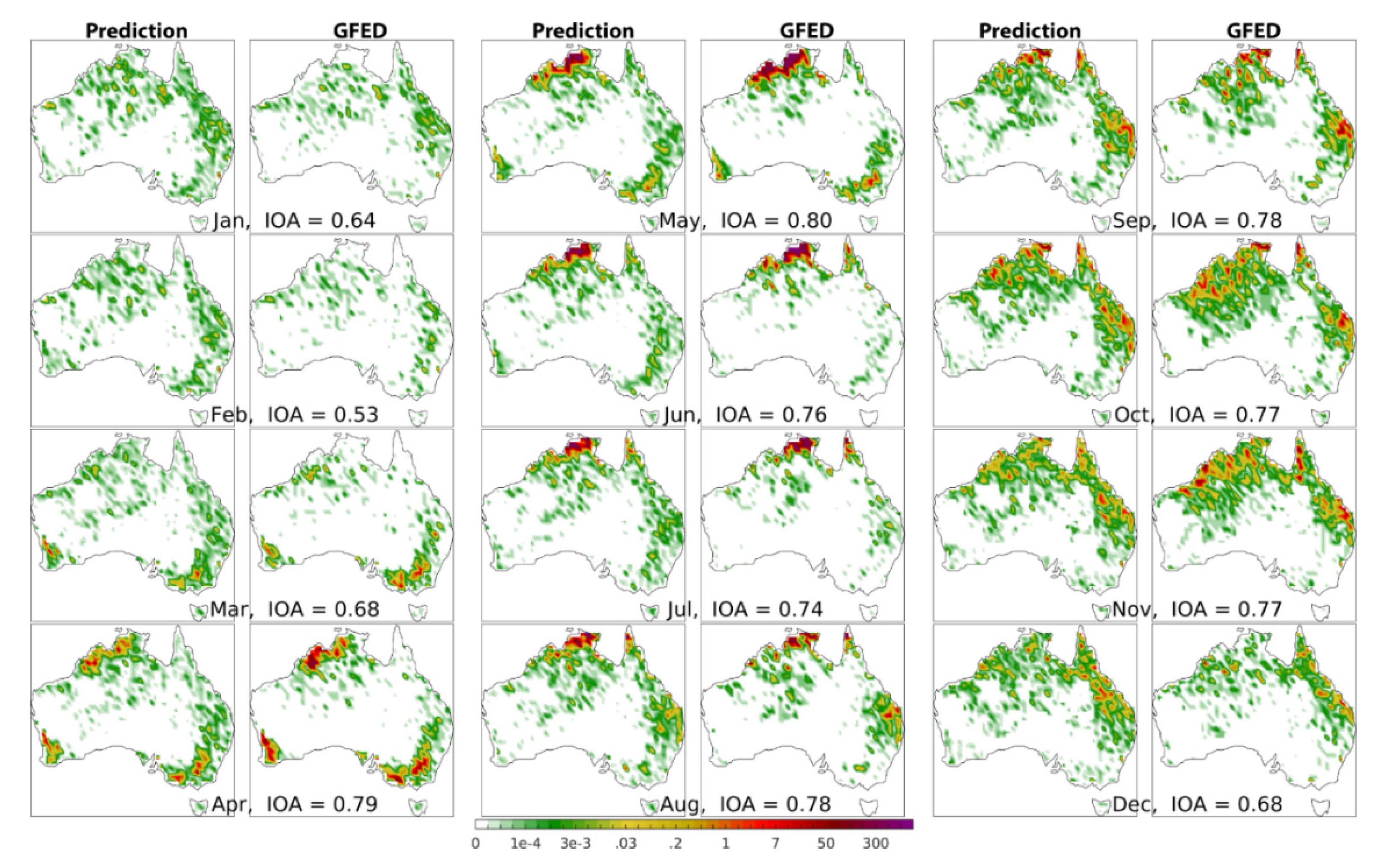
| Burned Area Regions | Predictor Parameters Field |
|---|---|
| Boreal North America (BONA) | Temperature, Pressure, Specific humidity, Sensible heat flux, Landcover |
| Temperate North America (TENA) | Temperature, Pressure, Specific humidity, Precipitation, Landcover |
| South America (SHSA) | Precipitation, Wind speed, Ground heat flux, Temperature, Vegetation type, ONI, AMO |
| Europe (EURO) | Temperature, Pressure, Wind speed, Landcover |
| Boreal Asia (BOAS) | Wind speed, Specific humidity, Sensible heat flux, Ground heat flux, Landcover |
| Central Asia (CEAS) | Temperature, Pressure, Wind speed, Precipitation, Landcover |
| Northern Africa (NHAF) | Precipitation, Potential evaporation, Vegetation type |
| Southern Africa (SHAF) | Precipitation, Temperature, Wind speed, Ground heat flux, Vegetation type |
| Equatorial Asia (EQAS) | Precipitation, Specific humidity, Ground heat flux, Sensible heat flux, Vegetation type, ONI |
| Australia (AUST) | Pressure, Specific humidity, Ground heat flux, Potential evaporation |
| Region | Neural Network | Regression Tree | GLM | ||||||||||||
|---|---|---|---|---|---|---|---|---|---|---|---|---|---|---|---|
| R2 | IOA | NRMSD | NME | NMB | R2 | IOA | NRMSD | NME | NMB | R2 | IOA | NRMSD | NME | NMB | |
| Boreal North America (BONA) | 0.53 | 0.7 | 0.15 | 54 | 28 | 0.46 | 0.57 | 0.28 | 63 | 41 | 0.33 | 0.41 | 0.38 | 72 | 58 |
| Temperate North America (TENA) | 0.84 | 0.73 | 0.14 | 29 | 14 | 0.73 | 0.68 | 0.26 | 43 | 25 | 0.61 | 0.59 | 0.36 | 56 | 41 |
| South America (SHSA) | 0.54 | 0.8 | 0.15 | 58 | 55 | 0.43 | 0.66 | 0.3 | 66 | 64 | 0.39 | 0.57 | 0.41 | 73 | 66 |
| Europe (EURO) | 0.58 | 0.74 | 0.14 | 44 | 29 | 0.49 | 0.62 | 0.3 | 53 | 40 | 0.36 | 0.54 | 0.44 | 65 | 52 |
| Boreal Asia (BOAS) | 0.77 | 0.79 | 0.16 | 43 | 15 | 0.69 | 0.71 | 0.39 | 49 | 24 | 0.51 | 0.58 | 0.48 | 57 | 36 |
| Central Asia (CEAS) | 0.49 | 0.7 | 0.15 | 55 | 49 | 0.4 | 0.63 | 0.36 | 60 | 56 | 0.33 | 0.48 | 0.39 | 70 | 62 |
| Northern Africa (NHAF) | 0.71 | 0.82 | 0.14 | 49 | 48 | 0.61 | 0.74 | 0.29 | 58 | 54 | 0.52 | 0.64 | 0.37 | 65 | 59 |
| Southern Africa (SHAF) | 0.6 | 0.82 | 0.14 | 50 | 47 | 0.53 | 0.71 | 0.31 | 57 | 49 | 0.42 | 0.62 | 0.43 | 68 | 63 |
| Equatorial Asia (EQAS) | 0.58 | 0.75 | 0.11 | 71 | 16 | 0.52 | 0.65 | 0.27 | 76 | 34 | 0.45 | 0.54 | 0.25 | 80 | 45 |
| Australia (AUST) | 0.2 | 0.56 | 0.2 | 94 | 25 | 0.18 | 0.55 | 0.26 | 98 | 36 | 0.15 | 0.46 | 0.35 | 99 | 54 |
| Mean of all regions | 0.59 | 0.74 | 0.15 | 54 | 33 | 0.51 | 0.65 | 0.3 | 62 | 42 | 0.41 | 0.54 | 0.4 | 70 | 54 |
© 2020 by the authors. Licensee MDPI, Basel, Switzerland. This article is an open access article distributed under the terms and conditions of the Creative Commons Attribution (CC BY) license (http://creativecommons.org/licenses/by/4.0/).
Share and Cite
Song, Y.; Wang, Y. Global Wildfire Outlook Forecast with Neural Networks. Remote Sens. 2020, 12, 2246. https://doi.org/10.3390/rs12142246
Song Y, Wang Y. Global Wildfire Outlook Forecast with Neural Networks. Remote Sensing. 2020; 12(14):2246. https://doi.org/10.3390/rs12142246
Chicago/Turabian StyleSong, Yongjia, and Yuhang Wang. 2020. "Global Wildfire Outlook Forecast with Neural Networks" Remote Sensing 12, no. 14: 2246. https://doi.org/10.3390/rs12142246
APA StyleSong, Y., & Wang, Y. (2020). Global Wildfire Outlook Forecast with Neural Networks. Remote Sensing, 12(14), 2246. https://doi.org/10.3390/rs12142246





